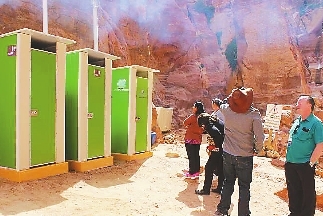
HOW many of us have our best ideas on the toilet? Zuraina Zaharin from Malaysia has built a business off the back of a loo break near Everest in the early 2000s when she was climbing in the region. “I was facing this problem: the toilet,” she explains. “It’s easy for men to do their business; they can just do it anywhere. But not for the ladies. We have to wait until we find some nice spot. Even then, I can’t do it. I just have to find the toilet.” Things didn’t improve upon discovering the facilities, however. “The last toilet at Everest base camp is a pit latrine,” Zaharin continues. “The smell’s so stinky.” The problem hasn’t exactly gone away. In 2018, 28,000 pounds of human waste was hauled from Everest’s two base camps during the climbing season, according to a local NGO tasked with cleaning up Everest, and dumped in open pits where it risks entering the water supply system. It was an extreme example of unsafely managed sanitation — something 4.5 billion people have to live with, according to the World Health Organization. Even flush toilets can bring their own problems, according to the UN, potentially “increasing water stresses” in countries with an inadequate water supply. Zaharin did not forget her Everest experience. When she attended a business forum in 2012 and listened to a man looking for investment in a sustainable toilet, ideal for locations with poor sanitation or little water, the stars aligned. Imad Agi from Sweden conceived a waterless toilet system that turns human waste into fertilizer without the harmful germs that can cause sickness if used in agriculture — ideal for organic farming. Agi and Zaharin went into business together as co-founders of EcoLoo, refining the toilet and taking it to market. The toilet works by adding a microbe solution to the waste chamber. The microbes break down human solids — normally in three to four days — leaving behind “ashes,” while liquid waste is turned into liquid fertilizer, which can be extracted via an outlet, Zaharin explains. EcoLoo recommends the microbe solution is topped up once a month and costs US$60 for a year’s supply. EcoLoo claims it’s less energy-intensive than a regular toilet because there’s no waste water to separate and process. The toilet range has gone on to win a clutch of awards and sell over 2,000 units in 21 countries. Notable examples include units installed at Petra, the UNESCO World Heritage Site in Jordan. Of course, it’s not the only waterless toilet on the block. Models have been around for decades in the developed world in one shape or form, incinerating, freezing or composting waste. But EcoLoo believes its low-energy product could have wide appeal. Zaharin still has one mountain to conquer: getting her toilet installed at an Everest base camp. A plan to have one fitted was scuppered by the 2015 Nepal earthquake. But the dream lives on. “Being an adventurer, I would never give up,” she says. (SD-Agencies) | 
